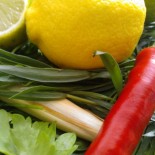Korean Drinks: Makgeolli
Makgeolli was the Korean drink I was most keen to try. It’s an unfiltered rice wine with a low alcohol percentage (typically between 6 and 8%) so has a cloudy, milky appearance. It’s unlike anything I’ve ever really come across before so when it came to tasting it, I had no idea what to expect.
It has the oldest history of all Korean alcoholic drinks, stretching back thousands of years. The name “makgeolli” comes from a word meaning rough or crude and it was the traditional drink of the Korean farmer, brewing makgeolli at home to be drunk as a refreshing and somewhat filling drink during a day in the fields. As it was brewed for nearly immediate consumption, it had a very limited shelf life that restricted widespread availability until recent years. In the last 15-20 years however, makgeolli has seen a huge surge in popularity amongst younger drinkers in Korea and is beginning to shake off its bad reputation as a poor quality peasant drink, perhaps in a similar way to the resurgence of cider and beer drinking in the UK. Home-brewed makgeolli is also growing in popularity.
Part of makgeolli’s recent rise in popularity is its reputation as a more healthy option. It has a lower alcohol content than strong soju, and because it is unfiltered, retains the vitamins and amino acids present in the rice. It’s reportedly very good for the skin, and is much lower in calories than any alternative (46 kcal per 100 ml, as opposed to 75 kcal for wine and 140 kcal for soju). A new trend for flavoured makgeolli has also helped boost and broaden its appeal, by adding fruits like mango and stawberry or other flavours such as honey or licorice to the bottle before fermentation. You can even find makgeolli desserts!
Makgeolli is served cold in a large bowl or jug, and drunk from individual ceramic or metal bowls although the drink is sold in plastic bottles or cartons (though some brands now use glass to suggest a better quality product). It’s a traditional accompaniment to jeon or Korean style pancakes so is associated with rainy days – the frying of the pancake is thought to sound like falling rain.
Improvements in the pasteurisation process have extended the shelf life of makgeolli and made it much more available worldwide in recent years, partly driven by its presence in Korean television series aired across Asia, and by demand from overseas Koreans – the US demand for makgeolli increased by 13 times during the period 2008-2011. Having tasted it before I started writing it, I think it might be a while before it’s a common sight in UK shops and bars though!
Makgeolli has a quite beery smell, and I would rather describe it as a rice beer than the typical phrase rice wine. It has an ale-like flavour and the brand I tried (E-dong, which is the leading brand outside South Korea) tasted quite fruity, with apple, pear and banana flavours. It is, however, a sour drink. I’m quite a fan of sour things in general, so I quite enjoyed this aspect but no-one else was too keen: especially when coupled with its yellow-grey colour and milky appearance that is rather off-putting. I was most keen to try the makgeolli because, while I understood the process of making it and expected the resulting appearance, I couldn’t imagine the taste at all. I knew it would be sour from some tasting information I’d seen of different brands, but didn’t expect the fruitiness. Of course, when you’re used to more bitter beers the sweet-sour taste is unexpected. Similarly, while it looks creamy and milky, it has a much thinner mouthfeel that is also not what you might expect. It’s an unusual drink, especially when compared to what we traditionally drink in the West. But once you get your head around the differences between its appearance and its actual flavour, I think it’s also really enjoyable, in particular as a contrast to the very spicy and savoury flavours of traditional Korean food
I’d be interested to try other brands of makgeolli to see what differences in taste there are, such as with wines grown in different places. Equally, I’d be keen to try flavoured makgeolli (had a little experiment by adding a bit of honey to the makgeolli, which mellowed out the sourness a lot) which I should think might be much more palatable to Western tastes. In my next post, I’ll be trying something which I think (hope) will be a little more of a crowd-pleaser – bokbunja ju, or black raspberry wine.
Click here to read about my previous post tasting the Korean spirit, soju.







